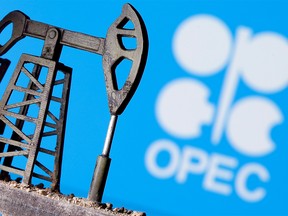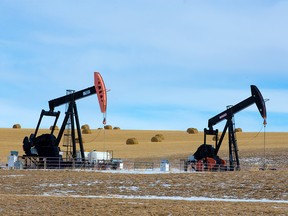
A surprising production cut by OPEC+ countries sent crude prices skyrocketing on Monday, propelling Canadian energy stocks higher and fuelling expectations that oil could be orbiting around US$100 a barrel later this year.
The Organization of Petroleum Exporting Countries and its partners announced Sunday they will reduce output by slightly more than one million barrels per day (bpd) beginning next month, with OPEC kingpin Saudi Arabia throttling down production by 500,000 bpd.
The group called it a “precautionary measure aimed at supporting the stability of the oil market.”
The news sent prices for West Texas Intermediate (WTI) crude higher, closing Monday at $80.42 a barrel, an increase of almost $5. It also marks a quick recovery from last month’s price dip, when benchmark U.S. oil tumbled below $65 a barrel amid international banking turmoil and concerns about its effect on energy demand.
“This caught the market by surprise. It certainly wasn’t in anyone’s playbook,” Al Salazar, vice-president of intelligence at energy analytics firm Enverus, said Monday.
“With this cut, it almost just locks it in, that we’ll get $100 a barrel in the back half of the year.”
This is the second production cut by OPEC+ since last fall, as it announced a two million bpd reduction in output (starting in November) after prices fell from more than $120 a barrel last summer. As well, expected Russian oil production has been reduced by 500,000 barrels per day until the end of this year.
Analysts anticipate oil prices are headed higher this year as demand increases when the summer driving season arrives. Several years of underinvestment by the global industry has also limited the sector’s ability to quickly increase output.
Recommended from Editorial
-

Energy sector notches its best day since October on OPEC+ cut
-
Oil soars more than $5/bbl, jolted by surprise OPEC+ output cuts
-

OPEC output cuts to roil markets, little room for others to respond
“It’s a perfect example of the fact that you just can’t rely on the day-to-day prices of oil,” Birchcliff Energy CEO Jeff Tonken said of Monday’s price hike.
“For every producer, it’s positive because now you’re going to generate more revenue. And it’s good for the Government of Canada and the province of Alberta because they’re going to generate more royalties and more taxes.
“So that’s very positive. The question is, how long will it last?”
Consultancy Rystad Energy projects the voluntary output cut, if fully met, will propel Brent crude prices this summer to hover around US$110 per barrel.
However, a sharp rise in energy prices would likely increase inflationary pressure on the global economy.
U.S. oil production is projected to climb by about 580,000 bpd this year, but the American industry doesn’t have a lot of additional capacity to make up for the gap due to OPEC’s latest cut, Salazar said.
Before the weekend decision, Enverus was expecting Brent oil prices to head up around US$100 a barrel in the fourth quarter.
“It certainly is at odds with what the U.S. is trying to do. It flies in the face of inflation concerns and trying to cool that down,” he said.
“It really sets up for an interesting year (in 2024) because OPEC might have to actually increase production next year to keep prices from overheating.”

For Canadian petroleum producers, the unexpected decision by the cartel means higher commodity prices and stronger cash flow levels in 2023 — if these conditions hold.
Shares in oilsands producers jumped on Monday’s news, with Cenovus Energy and MEG Energy both increasing by more than eight per cent. Junior oil producer Gear Energy climbed 11.7 per cent on the day, while Surge Energy saw its share price increase by almost six per cent.
Surge CEO Paul Colborne said the production cut by OPEC countries should accelerate the expected tightening of supply levels and global oil demand this year, pushing prices toward $100 a barrel.
“There’s going to be massive draws on inventories during the driving season and that’s the real story here,” said Colborne, who expects WTI crude will average around $95 a barrel this year.
“It’s a juggernaut, there’s nothing to slow it down.”
For Surge, every $1-a-barrel change over the course of the year increases its cash flow by about $8.7 million.
“We will just keep paying debt down and probably keep bumping our dividend, but we’re not going to race out and do a bunch more drilling,” Colborne said.

Petroleum producers expected commodity prices to moderate this year after oil markets soared in early 2022 following Russia’s invasion of Ukraine.
A survey last month of Canadian oil and gas executives by Raymond James asked respondents where they expect U.S. oil prices to be a year from now — and the average outlook was $85 a barrel.
Almost two-thirds of executives said they would use unexpected free cash flow this year to pay down debt, while 48 per cent would increase capital expenditures.
However, with weak natural gas prices persisting in North America and increased volatility rippling through oil markets, Tonken expects Canadian producers will be cautious about changing their plans for 2023.
“I don’t think you’re going to see anyone start drilling oil wells just because the price of (oil) moved $5 overnight,” he said.
“The idea I think you’ll hear from all producers is to be conservative over the next 12 months and position themselves for growth — or for higher commodity prices — as we move into the future.”
Chris Varcoe is a Calgary Herald columnist.
You can read more of the news on source
